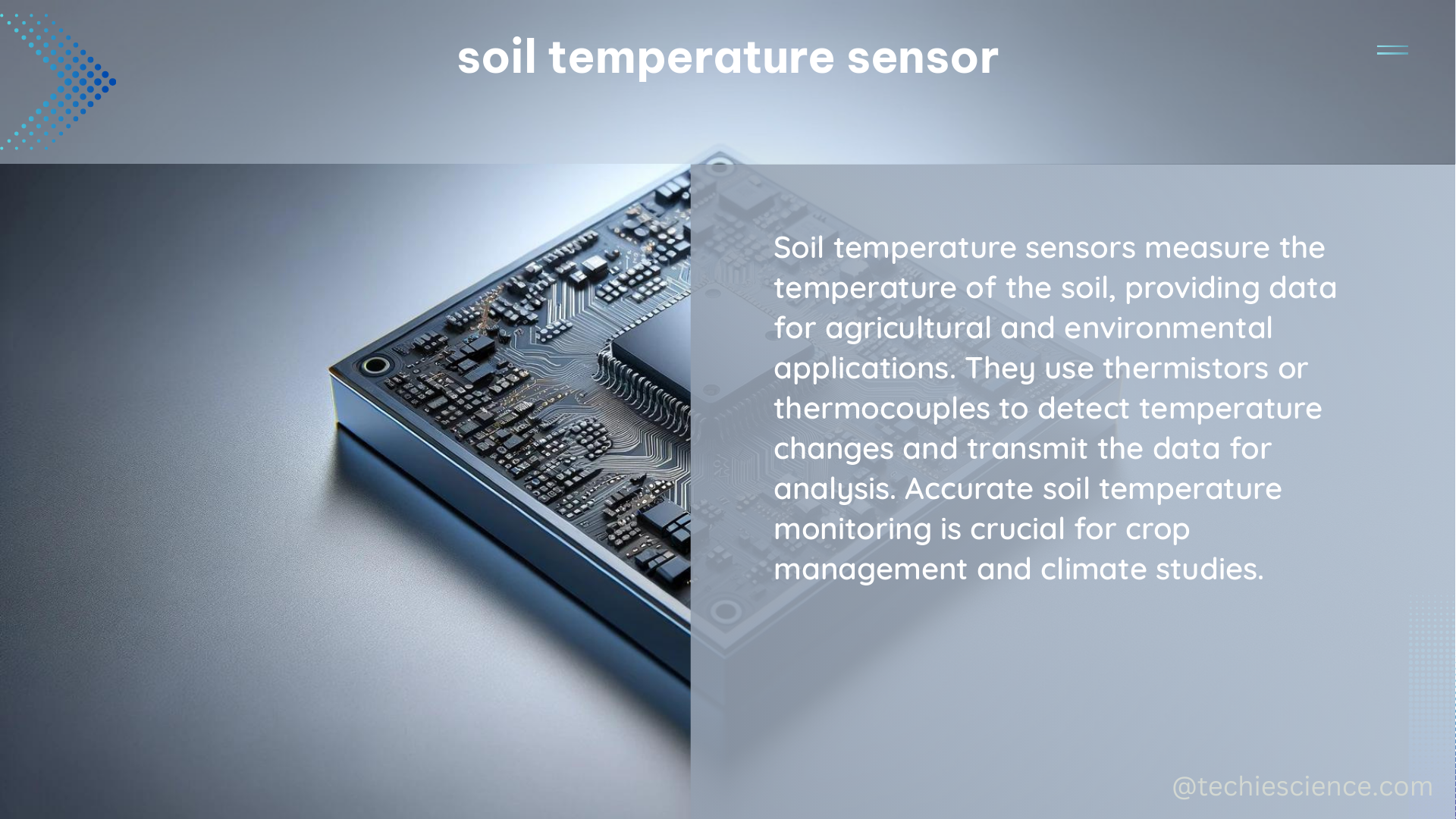Soil temperature sensors are essential tools for measuring the temperature profile of the soil at various depths, which is crucial for scientific-grade surface energy balance measurements. These sensors come in different designs, including thermocouples, thermistors, and averaging thermocouples, and are used for various applications such as agriculture, climate studies, and environmental monitoring.
Understanding Soil Temperature Sensors
Soil temperature sensors are designed to measure the temperature of the soil at specific depths, providing valuable insights into the thermal properties of the soil. These sensors are typically made of materials that are resistant to corrosion and can withstand the harsh environmental conditions found in the soil, such as exposure to moisture, chemicals, and physical disturbances.
Thermocouple Soil Temperature Sensors
Thermocouple soil temperature sensors are one of the most common types of soil temperature sensors. These sensors work by measuring the voltage difference between two dissimilar metals, which is proportional to the temperature difference between the measurement junction and the reference junction. Thermocouple soil temperature sensors are known for their accuracy, durability, and wide temperature measurement range, typically from -200°C to 1,800°C.
Thermistor Soil Temperature Sensors
Thermistor soil temperature sensors are another popular type of soil temperature sensor. These sensors use a temperature-sensitive resistor to measure the soil temperature. Thermistor soil temperature sensors are known for their high sensitivity, fast response time, and relatively low cost. They typically have a temperature measurement range of -50°C to 150°C.
Averaging Thermocouple Soil Temperature Sensors
Averaging thermocouple soil temperature sensors are designed to measure the average temperature over a specific depth range in the soil. These sensors use multiple thermocouple junctions along the sensor’s length to provide a single output that represents the average temperature. Averaging thermocouple soil temperature sensors are particularly useful for applications where the temperature profile at different depths is of interest, such as in agricultural and climate research.
Soil Temperature Sensor Specifications

When selecting a soil temperature sensor, it is essential to consider the following specifications:
Measurement Range
Soil temperature sensors are available with a wide range of measurement capabilities, from -50°C to 150°C for thermistor sensors and -200°C to 1,800°C for thermocouple sensors. The choice of measurement range will depend on the specific application and the expected soil temperature conditions.
Accuracy
Soil temperature sensors are designed to provide highly accurate measurements, with typical accuracy ranging from ±0.1°C to ±0.5°C, depending on the sensor type and manufacturer.
Response Time
The response time of a soil temperature sensor is the time it takes for the sensor to reach 63.2% of the final temperature reading when subjected to a step change in temperature. Faster response times are generally preferred, as they allow for more accurate and responsive measurements.
Cable Length and Termination
Soil temperature sensors are available with a variety of cable length and termination options, such as bare wire, connectors, or junction boxes. The choice of cable length and termination will depend on the specific installation requirements and the distance between the sensor and the data acquisition system.
Environmental Resistance
Soil temperature sensors must be able to withstand the harsh environmental conditions found in the soil, including exposure to moisture, chemicals, and physical disturbances. Sensors with robust construction and corrosion-resistant materials are essential for ensuring reliable and long-lasting performance.
Soil Temperature Sensor Applications
Soil temperature sensors are used in a wide range of applications, including:
- Agriculture: Monitoring soil temperature is crucial for understanding plant growth, soil health, and irrigation management.
- Climate Studies: Soil temperature data is used to study the impact of climate change on soil properties and ecosystem dynamics.
- Environmental Monitoring: Soil temperature sensors are used to monitor the thermal properties of the soil in various environmental studies, such as ecosystem restoration and land management.
- Building and Construction: Soil temperature data is used to design and optimize building foundations and underground infrastructure.
- Geotechnical Engineering: Soil temperature measurements are essential for understanding the thermal properties of soil and rock, which is crucial for geotechnical engineering projects.
Selecting the Right Soil Temperature Sensor
When selecting a soil temperature sensor, it is essential to consider the specific requirements of your application, such as the measurement range, accuracy, response time, cable length, and environmental resistance. Additionally, it is important to choose a sensor from a reputable manufacturer that provides reliable and well-supported products.
One example of a high-quality soil temperature sensor is the STP01 from Hukseflux. This sensor accurately measures the temperature profile of the soil at five depths close to the surface, with a measurement range of -30°C to 70°C. The STP01 features an online self-test using an incorporated heating wire to verify its measurement stability, making it an excellent choice for scientific-grade surface energy balance measurements.
Another option is the range of soil temperature sensors offered by Campbell Scientific, which are designed to ensure accurate and precise soil temperature measurements. These sensors come with a variety of cable length options, connector types, and termination options, allowing users to select the best fit for their specific application.
Conclusion
Soil temperature sensors are essential tools for a wide range of applications, from agriculture and climate studies to environmental monitoring and geotechnical engineering. By understanding the different types of soil temperature sensors, their specifications, and their applications, you can select the right sensor for your needs and ensure accurate and reliable soil temperature measurements.
Reference:
- Hukseflux STP01 Soil Temperature Sensor
- Campbell Scientific Soil Temperature Sensors
- GLOBE.gov Soil Temperature Protocol

The lambdageeks.com Core SME Team is a group of experienced subject matter experts from diverse scientific and technical fields including Physics, Chemistry, Technology,Electronics & Electrical Engineering, Automotive, Mechanical Engineering. Our team collaborates to create high-quality, well-researched articles on a wide range of science and technology topics for the lambdageeks.com website.
All Our Senior SME are having more than 7 Years of experience in the respective fields . They are either Working Industry Professionals or assocaited With different Universities. Refer Our Authors Page to get to know About our Core SMEs.